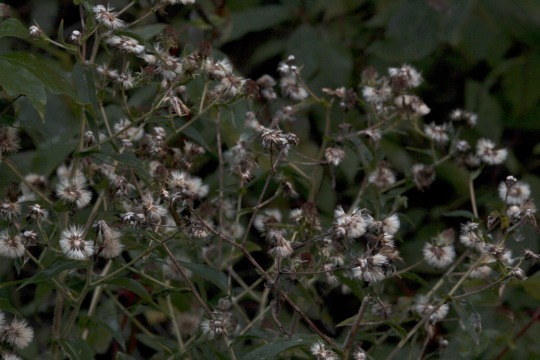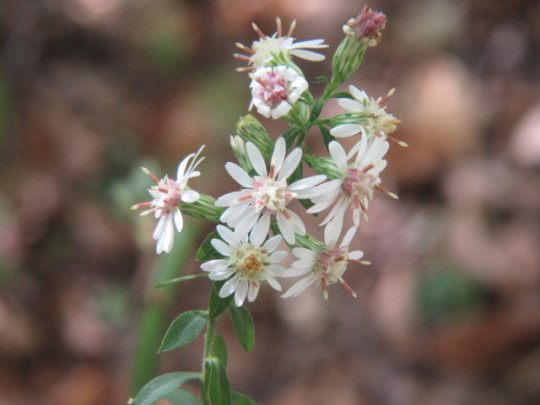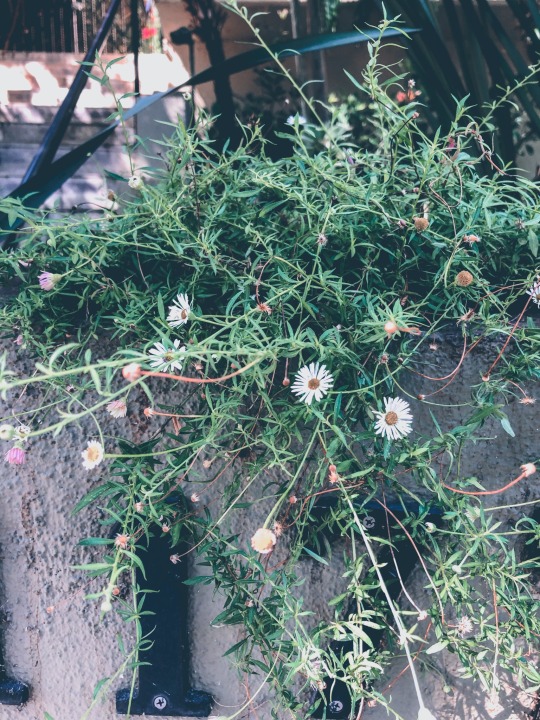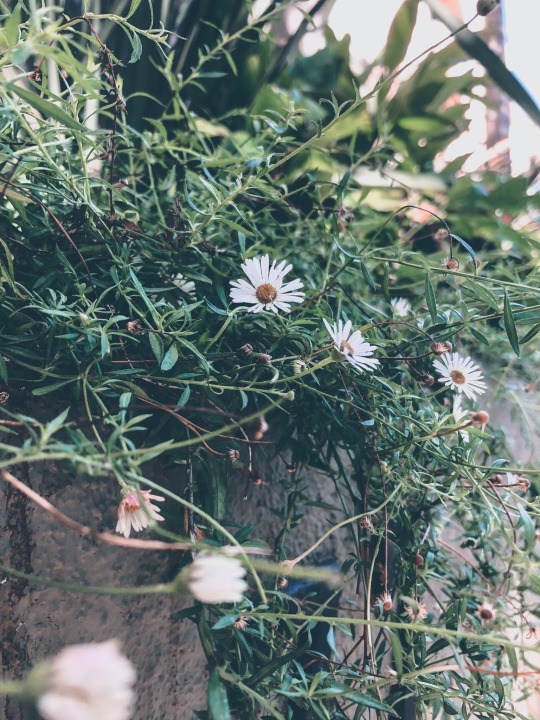#Symphyotrichum lanceolatum (Panicled Aster)
Explore tagged Tumblr posts
Text
My Garden Flowers Part 6
All photos mine, unedited.





















In order of appearance:
151. Canada Ginger (Asarum canadense) Not a ginger; the root just tastes like it. Flowers are springtime only and you miss them entirely if you don't get close to the ground!
152. Ohio Spiderwort (Tradescantia ohiensis) Was able to get her by calling up one of the plant places I order from directly during the COVID years. Their usual boxsets weren't listed as available so I asked if they ever would be that year, as a repeat customer, and listed the plants of theirs that I'd like and they put it together for me! She's a morning flower only, but she's stunning.
153. Harebell (Campanula rotundifolia) One of my very first. Grassy green foliage and cute little light blue bell-shaped flowers.
154. Panicled Aster (Symphyotrichum lanceolatum) Well behaved for an aster. When she starts growing onto the sidewalk I ease her back into the bed and she stays.
155. Smallflower Columbine (Aquilegia brevistyla) You can eat these flowers too but she's not quite as profuse as her taller red cousin so I'll wait before trying one.
156. Swamp Milkweed (Asclepias incarnata) Considered much more well-behaved behaved than her cousin the common milkweed, and therefore favoured in garden settings, I find she's not nearly as fragrant, but her flowers are stunning. In spite of her name she's quite drought tolerant. And while she doesn't spread by rhizome (well-behaved), she does seed prolifically. But like her common cousin, her young pods, young shoots, and flower clusters are edible cooked!
157. Wild Bergamot (Monarda fistulosa) She moves around. Died back in the area I initially planted her but has popped up in several places nearby and considerably further away. Her dried flowerheads still smell amazing after the winter if you give them a squeeze.
158. Wild Geranium (Geranium maculata) A beautiful plant from spring to fall. Her foliage is roundy in the early spring and then she has these wonderful pink flowers against the dark green of her leaves. After the flowers are done the foliage is still interesting, and then it turns red in the fall.
159. Sweet Corn (Zea mays saccharata rugosa) Not technically native to the area and can't survive the winter, but grown here long before colonization. She makes a rather handsome garden plant in my opinion.
160. Purple Poppymallow (Callirhoe involucrata) Just a strikingly beautiful groundcover for a dry area.
161. Smooth Rose (Rosa blanda) She doesn't bloom very often and suckers very slowly, but a non-aggressive rose is exactly the sort I need for property that isn't mine.
162. Anise Hyssop (Agastache foeniculum) Beloved of the bumblebees, and I like to use her in flavouring my pies.
163. Redroot Amaranth (Amaranthus retroflexa) Not pictured as I don't have pictures yet. Not sure if she reseeded this year. I rescued her from a fallow area and she has reseeded at least once, so we'll see.
164. Purslane (Portulaca oleracea) Not pictured as I don't have pictures yet. Also one I rescued from a fallow area. I don't know why so many people don't like purslane. She's a cute succulent groundcover in my opinion, and a nice snack too.
165. Crowfoot Violet (Viola pedata bicolor) Not pictured as I don't have pictures yet.
166. Mountain Laurel (Kalmia latifolia) The only one I planted without any known food use--it's poisonous--but purely because I saw a picture in David Attenborough's The Secret Life of Plants and always wanted one.
167. Wild Chives (Allium schoenoprasum) Beautiful flowers and tasty all around. What more could one want?
168. Field Thistle (Cirsium discolor) The parent of that field thistle, which appears to be dead in both halves, sadly, though her younger siblings are still alive. Her flowers are quite lovely and I do hope to see them in the garden next year if they don't get cut too.
169. Canada Milk Vetch (Astragalus canadensis) Interesting yellow-green flowers become deceptively inviting bean-looking fruits, but those don't have a known edible use. Other parts do, though.
170. Rattlesnake Master (Eryngium yuccifolium) I can't remember if she's named as such because she was used to treat snakebites back in the day or if her flowerhead kind of looks like snake's rattle. Anyway she's interesting.
171. Compass Plant (Silphium laciniata) Not pictured because she hasn't made a flowerstalk yet. Must be young. Her relative the cup plant has been flowering reliably every year.
172. Heath Aster (Symphyotrichum ericoides) Not pictured as I haven't got any pictures yet.
173. Rough Blazing Star (Liatris aspera) A very drought-tolerant blazing star species. Not quite as showy as dense blazing star but a nice tall plant for the back of a sunny garden.
174. Blanketflower (Gaillardia xgrandiflora) A hybrid with one parent native to here and the other out west. Not sure if she's fertile or not. Got her because I needed another plant for the minimum order and she looks nice enough not to be mistaken for a weed.
175. Graceful Cinquefoil (Potentilla gracilis) Flowering in her first year in the garden! She's hopefully going to form a groundcover in a relatively short period, over which her flowerstalks will sway in the breeze.
176. Pale Purple Coneflower (Echinacea pallida) Glad I got pictures before the landlord cut her. (:
177. Wild Savoury (Clinopodium arkansana) Not pictured as I don't have pictures yet.
178. Small-Leaved Pussytoes (Antennaria parvifolia) Not pictured as she hasn't flowered yet.
179. Common Yarrow (Achillea millefolium nigrescens) Not pictured as I haven't seen any flowers yet.
180. Red Elder (Sambucus pubens) Not pictured as she hasn't flowered yet.
#blackswallowtailbutterfly#my photos#photography#my garden#garden flowers#native plant gardening#native flowers of Carolinian Canada and USA
15 notes
·
View notes
Text

Panicled Aster, Symphyotrichum Lanceolatum
1 note
·
View note
Text
Symphyotrichum Workout
Symphyotrichum lateriflorum (Calico Aster) on 10-9-22, #916-11. Hello everyone! I hope this post finds you well. The past week has been fairly cool and it finally rained. This is a perfect time of the year to get dirty and do some fall cleanup. One of the most baffling genera of plants on the farm has been the Symphyotrichum. Even pronouncing it can be a challenge. It’s…

View On WordPress
#Symphyotrichum lanceolatum (Panicled Aster)#Symphyotrichum lateriflorum (Calico Aster)#Symphyotrichum novae-angliae (New England Aster)#Symphyotrichum ontarionis (Ontario Aster)#Symphyotrichum pilosum (Hairy White Oldfield Aster)#Symphyotrichum praealtum (Willowleaf Aster)
0 notes
Text



White-panicle aster
Symphyotrichum lanceolatum
A completely impromptu poem nobody asked for or wanted:
Your melody hums to many.
Walk into the ring
And fall prey to the faerie.
Lured by your delicate song and
Calls of innocent worry.
#og posts#study blog#studyblr#study aesthetic#plantblr#plantlove#plants#plantphotography#plantcore#cottage aesthetic#cottagecore#fairy core#nature core#naturephotography#floral pics#floral#poetryblr#poetry#tumblr poem#prose poem#faerycore#fae folk#faerie#faery garden#faerie aesthetic
9 notes
·
View notes
Photo
monarch butterfly (Danaus plexippus),
other common names depending on region include milkweed, common tiger, wanderer, and black veined brown. It may be the most familiar North American butterfly, and is considered an iconic pollinator species.
panicled white aster (Symphyotrichum lanceolatum, formerly: Aster lanceolatus)

203 notes
·
View notes
Text
Went outside to check which of my plants is emerging after their winter sleep/whether they made it.
So far the plants that have made it for sure are:
Allium cernuum (Nodding onion)
Allium schoenoprasum (Chives)
Anaphalis margaritacea (Pearly everlasting)
Amelanchier canadensis (Canadian serviceberry)
Aquilegia brevistyla (Smallflower columbine)
Aquilegia canadensis (Eastern red columbine)
Arctostaphylos uva-ursi (Common bearberry/Kinnikinnick)
Asarum canadense (Canada ginger)
Campanula rotundifolia (Harebell)
Echinacea purpurea (Purple coneflower)
Gaultheria procumbens (Eastern teaberry/American wintergreen)
Geum triflorum (Prairie smoke)
Hierochloe odorata (Vanilla grass/Sweetgrass)
Lindera benzoin (Spicebush)
Lonicera villosa (Mountain fly honeysuckle) both!
Monarda didyma (Scarlet bee-balm)
Monarda fistulosa (Wild bergamot)
Oenothera biennis (Evening primrose)
Prunus americana (American plum)
Prunus serotina (Black cherry)
Rhus aromatica (Fragrant sumac)
Rosa blanda (Smooth rose)
Rubus strigosus (American red raspberry)
Sambucus canadensis (Common elderberry/American black elderberry)
Silene acaulis (Moss campion)
Spiraea alba (White meadowsweet)
Urtica dioica (Stinging nettle)
Vaccinium angustifolium (Lowbush blueberry/Wild blueberry)
Vaccinium corymbosum (Northern highbush blueberry/Swamp blueberry)
Viola canadensis (Canada violet)
The plants that have probably/seem to have made it but I can’t quite tell yet (it’s still March after all):
Agastache foeniculum (Anise hyssop/Giant hyssop)
Allium ursinum (Wild garlic)
Asimina triloba (Pawpaw) I might not know until June for these...
Cercis canadensis (Redbud)
Helianthus nuttalli (Nuttall’s sunflower)
Helianthus pauciflorus (Stiff sunflower)
Myrica gale (Sweet gale)
Opuntia fragilis (Fragile prickly pear)
Viburnum cassinoides (Witherod viburnum)
Viburnum lentago (Nannyberry)
Viola blanda (Sweet white violet)
Zizia aurea (Golden alexanders)
The ones I have no idea about yet (again, it’s early):
Asclepias incarnata (Swamp milkweed)
Asclepias tuberosa (Butterflyweed)
Cerastium arvense (Field chickweed)
Erythronium americanum (Trout lily) I’ll know soon
Galium boreale (Northern bedstraw)
Geranium maculatum (Wild geranium)
Lilium michiganense (Michigan lily)
Mentha arvensis (Wild mint)
Mertensia paniculata (Tall bluebells)
Pycnanthemum tenuifolium (Slender mountain mint)
Symphyotrichum ciliolatum (Fringed blue aster)
Symphyotrichum lanceolatum (Panicled aster)
And the ones I think didn’t make it (hope I’m wrong) are:
Cornus canadensis (Bunchberry/Creeping dogwood) was doing fine but a squirrel dug it up a bad time...
Hibiscus moscheutos (Swamp rose mallow) was doing fine but people KEPT STEPPING ON IT THERE’S LITERALLY A SIDEWALK RIGHT BESIDE IT!!!
Pycnanthemum virginianum (Virginia mountain mint) WHO DECIDED THAT RAISED WINDOW BED SHOULD BE WHERE THE CIGARETTE BUTTS GO???
Solanum ptycanthum (Eastern black nightshade) They’re technically annuals/biennials, but hopefully it reseeded itself with the berries I didn’t eat.
So I can’t go to my old city to see my grandparents and friends. I can’t go to Quebec to see my sister, mom, nieces, and nephew. I can’t go to the parks because people have been gathering there so now there’s a fine. But I can still go to the ravine (I would LOVE to see people try to gather there; if the mud doesn’t get them, the thorns and pricklies will) and I still have my garden.
2 notes
·
View notes